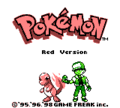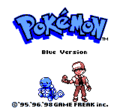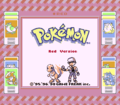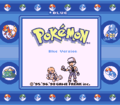Pokémon Red and Blue Versions
- Pokémon Red redirects here. For the Japanese game with the same name, see Pokémon Red and Green Versions.
- Pokémon Blue redirects here. For the Japanese game with the same name, see Pokémon Blue Version (Japanese).
| Pokémon Red Version | |
|---|---|
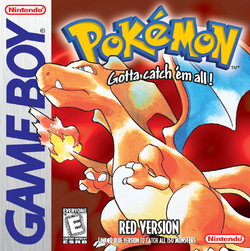 Pokémon Red Version's boxart, depicting Charizard | |
| Pokémon Blue Version | |
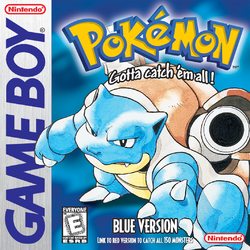 Pokémon Blue Version's boxart, depicting Blastoise | |
Basic info
| |
| Platform: | Game Boy (enhanced for the Super Game Boy), Nintendo 3DS (Virtual Console) |
| Category: | RPG |
| Players: | 2 players simultaneous |
| Connectivity: | Game Link Cable (Game Boy) 3DS Wireless (3DS VC) |
| Developer: | Game Freak |
| Publisher: | Nintendo |
| Part of: | Generation I core series |
Ratings
| |
| CERO: | Not applicable |
| ESRB: | E |
| ACB: | G (Game Boy) PG (3DS VC) |
| OFLC: | G8+ |
| PEGI: | 12 |
| GRAC: | Not applicable |
| GSRR: | N/A |
Release dates
| |
| Japan: | As Red and Green: February 27, 1996 (Game Boy) February 27, 2016 (3DS VC) As Blue: October 15, 1996 (Game Boy, CoroCoro Comic) October 10, 1999 (Game Boy, retail) February 27, 2016 (3DS VC) |
| North America: | September 28, 1998[1] (Game Boy) February 27, 2016 (3DS VC) |
| Australia: | October 23, 1998 February 27, 2016 (3DS VC) |
| Europe: | October 5, 1999 (Game Boy)[2][3] February 27, 2016 (3DS VC) |
| South Korea: | Unreleased |
| Hong Kong: | As Red, Green, and Blue: February 27, 2016 (3DS VC) |
| Taiwan: | As Red, Green, and Blue: February 27, 2016 (3DS VC) |
Websites
| |
| Japanese: | N/A |
| English: | The Pokémon Company International (Game Boy & Virtual Console) Nintendo (GB, Red; needs Flash Player) Nintendo (GB, Blue; needs Flash Player) Nintendo (VC, Red) Nintendo (VC, Blue) |
Pokémon Red Version and Pokémon Blue Version were the first Pokémon games to be released outside of Japan, becoming available in North America on September 28, 1998,[1] in Australia and New Zealand on October 23, 1998 and in Europe on October 5, 1999.[2][3] In North America, the pair closely followed the debut of the anime's English dub, which began airing on September 8, 1998,[4] and within a year, Pokémon was well known as a popular Nintendo franchise.
Pokémon Red, Blue, and Yellow were released for the Nintendo 3DS Virtual Console in North America, Europe, Australia, and New Zealand on February 27, 2016, the Pokémon 20th Anniversary. This release is compatible with Poké Transporter, which can send Pokémon from this game to Pokémon Bank, where they can be withdrawn in Pokémon Sun, Moon, Pokémon Ultra Sun and Ultra Moon.
Unlike later generations, Red and Blue were not the same as their corresponding Japanese releases Pokémon Red and Green. Besides Pokémon distribution, the aspects of Red and Blue such as graphics, script, and sprite designs are instead based on Pokémon Blue.
Despite being released towards the end of Game Boy's lifespan, they quickly became the best-selling non-bundled games released for the Game Boy as well as being the best-selling role-playing games of all time.
Plot
Illustrating the original Pokémon gameplay concepts, the player (canonically known as Red) begins his game in Pallet Town, a small town in the Kanto region, on the same day as his former best friend and now rival. After meeting up with Professor Oak while trying to leave for Route 1, both the player and their rival are asked by Oak to choose a starter Pokémon, Bulbasaur, Charmander, or Squirtle, from the desk near him. Oak allows the player to choose first and the rival quickly gets jealous, chooses the starter whose type is super-effective against the player's starter, then challenges the player to a battle.
After the battle, Oak allows the two new Trainers to leave for their journey across Kanto. Stopping in Viridian City's Poké Mart, the player will find that a package has come in for the professor, and the clerk asks that it be delivered to him. After this has been completed the professor gives one Pokédex to the player and one to the rival, and sends them on their way. Viridian City has a Gym; however, it is locked.
From here, the player has his first encounter with other Trainers, on Route 2 and in Viridian Forest, and his first encounter with a Gym Leader: Brock the Rock-type Gym Leader of Pewter City. After his defeat, journeying along Route 3 and through Mt. Moon brings the player face to face with the regional villainous team, Team Rocket, who are attempting to extract rare Fossils from the cave. Their defeat allows the player to continue through the cave, obtain the Dome Fossil or Helix Fossil which can be regenerated into Kabuto and Omanyte, and continue onto Route 4, which leads directly into Cerulean City, where another Gym is. This one, however, is run by Misty, and specializes in Water-type Pokémon. To the north, as well, there are two routes leading up to Bill's cottage. On the way, the player is confronted with a trainer who tries to persuade him to join Team Rocket. When the player reaches Bill's cottage and frees him of his transformation into a Pokémon, he will give the player a ticket for the S.S. Anne, a luxury ship moored in Vermilion Harbor and filled with Trainers. Taking a shortcut through a house burglarized by Team Rocket, the player finally arrives at Route 5.
After traveling down Routes 5 and 6, using the Underground Path to bypass Saffron City, the player finally arrives in Vermilion. This city is home to another Pokémon Gym; however, the way to it is blocked by a small tree. The only thing to do is to show the ticket to the Sailor guarding the harbor, allowing entry into the S.S. Anne. It is here, after assisting the captain with his seasickness, that the player will obtain the first of the five Hidden Machines available in the game, containing Cut. With this, and the Cascade Badge, the tree blocking the way to Vermilion Gym can be easily cut through, and Lt. Surge, a Gym Leader specializing in Electric-types, can be challenged. From here, Route 11 beckons, as does Diglett's Cave, through which is the only way to get back to Route 2, and a second HM, containing Flash held by one of Professor Oak's aides on Route 2. The player takes a brief detour to Pewter City's museum's back entrance which was previously blocked due to a Cut-able tree, which can now easily be bypassed. The player obtains the Old Amber in the museum. Heading back to Diglett's Cave, and to Vermilion, the player must go to Cerulean and to the east, onto Route 9 and towards the Rock Tunnel.
Rock Tunnel, a still undeveloped natural tunnel between the sections of Route 10, is pitch black inside; for this reason, Flash is recommended, but not required, for navigation of it. Finally reaching Lavender Town, the only town in Kanto without a Pokémon Gym besides Pallet, there is not much to do; the local Pokémon Tower is haunted. From here, Route 8 leads to Saffron City, but it again must be bypassed by way of another Underground Path, which has its other entrance on Route 7, on the west side of Saffron. Celadon City, the home of the fourth Gym which specializes in Grass-type Pokémon, is just a short walk further. Like the Vermilion Gym, the Celadon Gym also has a small tree blocking the way to its entrance, and an old man outside.
The Rocket Game Corner in Celadon is not what it appears to be. In fact, the Game Corner itself is merely the above-ground portion of a sprawling underground complex: the Rocket Hideout. The Team Rocket boss, Giovanni, appears for the first time here, and after his defeat, flees, leaving behind a Silph Scope. A Silph Scope is required to fully navigate the Pokémon Tower inside of Lavender Town that the player encountered earlier.
After this, the Pokémon Tower can be navigated, and the ghosts haunting it are revealed to be Gastly and Haunter. In front of the stairs to the final floor, blocking the way, is also a final spirit, that of a deceased Marowak that was killed by Team Rocket when they captured her child. Making it all the way to the top reveals Mr. Fuji held hostage by Team Rocket grunts, who will leave when they are defeated. Fuji gives away the Poké Flute, and with that, the Snorlax blocking Route 11 and Route 16 can finally be moved away. Another HM, containing Fly, can be obtained easily by cutting away a tree blocking the northern section of Route 16.
Now the player is presented with a choice of how to get to Fuchsia City. Traveling down either way the Snorlax are blocking, a faster way via Routes 16, 17, and 18 on Cycling Road, or down the Silence Bridge of Routes 12, 13, 14, and 15, inevitably brings one to the southernmost city in continental Kanto, Fuchsia City, home of Koga of the Poisonous Fuchsia Gym and the Kanto Safari Zone. The Safari Zone is currently running a contest: the person to reach a specific rest house first will win yet another HM, containing Surf. Finding the Safari Zone Warden's Gold Teeth also will have him reward the player with the final of Kanto's HMs, containing Strength.
The player then goes back to either Celadon City or Lavender Town, encountering the other Snorlax on the way back. After stopping off at the Celadon Department Store and buying a drink at a vending machine, Saffron City can finally be entered. However, Team Rocket is guarding almost every door in the city, including that of the local Pokémon Gym! One of the open buildings, however, is the unofficial Fighting-type Pokémon Gym. After the player defeats the Fighting Dojo, he is entitled to either a Hitmonchan or a Hitmonlee. The city's centerpiece building, Silph Co.'s headquarters, has also been infiltrated by the organization, and at the top, waiting in the boardroom, is the Team Rocket Boss, Giovanni, appearing for a second time, demanding that the president give him the Master Ball that the company had developed. After his defeat, he flees.
After Team Rocket clears out of Saffron City, all buildings previously blocked are now open, as well as the Gym. The Gym Leader, Sabrina, specializes in Psychic-types. The floor, as well, is covered in warp tiles that make it difficult to navigate. After Sabrina's defeat, the player makes his way back to Fuchsia City again and heads out to obtain the rest of the Badges.
With six Badges in hand, and five HMs in the bag, finally the player can adventure onto the open sea of Routes 19 and 20. A short way across them, of course, is a minor obstacle: the Seafoam Islands. After they have been navigated through, the player can continue on Route 20 to Cinnabar Island, home of Blaine's Fire-type Gym. There are also several more facilities on the island, including one that actually revives Pokémon Fossils. After Blaine's defeat, only the final Gym, that of Viridian City, remains.
Finally unlocked, the Gym, whose leader specializes in Ground-types, is revealed to be none other than the boss of Team Rocket himself, Giovanni! After his defeat, he vows to disband Team Rocket and disappears. Now with eight Badges, all that lies ahead is the Pokémon League at Indigo Plateau, conveniently at the end of Route 23.
The Elite Four await challengers, those who have proven themselves worthy by getting all eight Badges and making it through Victory Road will face them, in order. Lorelei, who trains Ice-type Pokémon is first, followed by Bruno, whose specialty is Fighting, Agatha, whose specialty is Ghost, and finally Lance, who specializes in Dragon-types. After defeating these four, the reigning Pokémon Champion challenges the player to a final battle, and the Champion is none other than the player's own rival! After his defeat, Oak arrives and tells the player that he won because he cares better for his Pokémon, and the player's current party are added to the Hall of Fame.
After the credits roll, the player is back in Pallet Town. The previously closed Cerulean Cave is now open, and the powerful Mewtwo can be found inside.
Blurb
You've finally been granted your Pokémon Trainer's license. Now, it's time to head out to become the world's greatest Pokémon Trainer. It's going to take all you've got to collect 150 Pokémon in this enormous world. Catch and train monsters like the shockingly-cute Pikachu. Face off against Blastoise's torrential water cannons. Stand strong when facing Pidgeot's stormy Gust. Trade with friends and watch your Pokémon evolve. Important—no single Pokémon can win at all. Can you develop the ultimate Pokémon strategy to defeat the eight Gym Leaders and become the greatest Pokémon Master of all time?
Features
Gyms
Players are introduced to the first eight Pokémon Gyms of the series, each with their own type affiliation, led by Brock (Rock), Misty (Water), Lt. Surge (Electric), Erika (Grass), Koga (Poison), Sabrina (Psychic), Blaine (Fire) and Giovanni (Ground).
Elite Four
The Elite Four of Kanto are a step above the rest, all located at Indigo Plateau and ready to take on all challengers. In order, they are Lorelei (Ice), Bruno (Fighting), Agatha (Ghost) and Lance (Dragon). The final battle is against the Pokémon Champion, the rival, who does not have a type specialization.
Pokémon
Each game contains pre-recorded data on 151 different species of Pokémon, including Mew, a Pokémon unavailable to players of either game under normal conditions. Despite this, not all Pokémon are available to the player, regardless of version; trades must occur between players in order to complete their Pokédex without the use of cheats or glitches. Mew is the only Pokémon in these games that must be acquired through attending either a Nintendo sponsored event, a glitch, or cheating.
Game-exclusive Pokémon
The following Pokémon are only obtainable in one game of this pair. In order to obtain Pokémon exclusive to the other game of this pair, they must be traded either from that game or from another compatible game of Generation I or Generation II which has that Pokémon available.
|
| ||||||||||||||||||||||||||||||||||||||||||||||||||||||||||||||||||||||||||||||||||||||||||||||||||||||||||||||||||
Connectivity
Players may trade Pokémon between two cartridges or battle with another cartridge using a Game Boy Game Link Cable. To take full advantage of this feature, several Pokémon are exclusive to each game of the pair and others require trading to evolve, making trading necessary to complete the Pokédex. The games can trade and battle with Western versions of Red, Blue, and Pokémon Yellow. They can also trade with Western versions of Pokémon Gold, Silver, and Crystal via the Time Capsule. Red and Blue are completely incompatible with games from Generation III onward.
Trades between Pokémon games in different languages are possible; however, a Japanese game cannot connect with a non-Japanese game without causing corruption. This is due to the fact that the games cannot automatically translate the Pokémon data from Japanese to a different language or vice versa, since neither game fully encodes both kana and the Latin alphabet (only encoding one fully and the other partially). If a battle between a Japanese game and a non-Japanese game is attempted, the battle simply does not work, with the save files left unharmed.
Red and Blue are compatible with Pokémon Stadium and Stadium 2. While link battles are not possible directly between Pokémon Red and Blue and the Generation II games, a player may challenge a Generation II game using Pokémon Stadium 2.
Virtual Console
The Nintendo 3DS Virtual Console releases use 3DS wireless communication as a substitute for the Game Link Cable. Japanese and non-Japanese Generation I core series games do not recognize each other when attempting to link them via 3DS wireless communication.
Using Poké Transporter, the entirety of Box 1 can be sent from the Generation I core series games to Pokémon Bank (regardless of language), from where they can be withdrawn in the Generation VII core series games.
Differences in the Virtual Console release
The Nintendo 3DS Virtual Console releases can link with other Virtual Console Generation I and II core series games via Nintendo 3DS wireless communication, simulating the Game Link Cable. When initiating a link, the Virtual Console menu on the touch screen replaces the Cable Club attendant's dialogue.
Using Poké Transporter, Pokémon can be sent from the Generation I core series games to Pokémon Bank, from which they can be withdrawn in the Generation VII core series games.
The moves Blizzard, BubbleBeam, Confusion, Dream Eater, Explosion, Guillotine, Hyper Beam, Mega Kick, Mega Punch, Psychic, Reflect, Rock Slide, Selfdestruct, Spore, and Thunderbolt had their animations changed slightly to tone down the flashing.
Development
- This section is about general development info. For development leftovers and unused content, see Pokémon Red and Green beta.

|
This section is incomplete. Please feel free to edit this section to add missing information and complete it. Reason: Wikipedia has nifty info from official sources. Post it and cite it here |
As Red, Green, and Blue
Female player character

There were originally plans for a female protagonist as suggested by the artwork on the cover of the official guidebook for Pokémon Red and Green and Pokémon Blue. Green from Pokémon Adventures seems to be based on her. The character was redesigned and included in the remakes of the games, to continue the standard of including a female protagonist.
No Mew present
According to the interview by Satoru Iwata with Tsunekazu Ishihara and Shigeki Morimoto about the release of Pokémon HeartGold and SoulSilver, localized as Iwata Asks, they admitted that after the debugging tools were removed, they added Mew in the remaining space on the ROM. Nintendo thought that this would have been risky because altering the internal data after completing the testing period meant that any new bugs and/or glitches created by adding data without referring to debugging tools would have been much harder to fix. Standard programming practices usually discourage altering the source code and not testing it just before releasing the software to the customer.[5]
Poké Balls
- Main article: Poké Ball
Some concept art depicts Poké Balls on the ground, in two pieces. This is most likely just a carryover from when Pokémon was still the concept of Capsule Monsters. Strangely, the original Poké Ball sprites from Pokémon Red and Green lack the button in the center of the Poké Ball.
Rebattling Trainers
In an interview with Shōko Nakagawa in her book Shōko Nakagawa: Pokémon Taught Me The Meaning of Life, Tsunekazu Ishihara revealed that originally, the game was programmed to trigger a battle with each Trainer any time the player walked by them, even if the player had already defeated them in battle previously. The wild Pokémon encounter rate was also significantly higher originally. The Trainer rebattling was omitted from the final release and the wild Pokémon encounter rate was significantly reduced.[6]
Concept art

During a gaming exhibition called Game On, early concept art of Pokémon Red and Green by Ken Sugimori was featured, along with pre-release material from Pokémon Ruby and Sapphire. The concept art depicts rough versions of various concepts that made it into the final releases of the Generation I games. They seem to include various battles, the Safari Zone, Red riding on a Lapras, a Blastoise, Celadon City, Silph Co., and a town with a fountain which could have been reworked into Celadon City. Some other Pokémon are identifiable in a raw or semi-normal form, such as Gastly, and others are prototypical of an entire class of Pokémon, such as a basic Dragon-type.
GameCenter CX

|
This section is incomplete. Please feel free to edit this section to add missing information and complete it. Reason: Expand based on the information provided by Satoshi Tajiri, if applicable |
A Japan-exclusive special Pokémon episode of GameCenter CX, known as Retro Game Master outside of Japan, included an interview with Satoshi Tajiri, where he revealed early Pokémon character profiles of Nidoking, Slowbro and Kadabra. Notably, they are given a National Pokédex number which matches their internal index number, rather than their final Kanto Pokédex number. Nidoking, for instance, is noted as being #007, rather than #034, either suggesting that there was another method of ordering the Pokémon proposed, or that they reflect their ordering in the internal data. The latter is supported by interviews with Ken Sugimori, which verify that Rhydon, which has an index number of 001, was the first Pokémon ever created, and early sketches from Capsule Monsters featuring Rhydon. Nidoking is also referred to as 「マイコー♂」 Maikō♂, indicating that there were either placeholders or alternate names for Pokémon before the development of Pokémon Red and Green had finished.
In addition to this, it was confirmed in an interview with Shigeki Morimoto that there were originally going to be 190 Pokémon in Generation I, indicating that the 39 MissingNo. found in the internal index are formatted Pokémon.[7]
Sprites
Different front sprites of Pokémon were planned for Pokémon Blue, notably the ones for Raticate, Rhydon, Ditto, Dragonair and Mewtwo. These were featured in the November 1996 issue of CoroCoro, which published general information about the game.[8]
As Red and Blue
Pokémon names

During the promotional period that preceded the English release of both the anime and Pokémon Red and Blue, a large amount of Pokémon were shown with different names from those they had in the final releases. Some of these names were similar to their final names, but some were quite close to their Japanese names, and others were completely different from any current Pokémon name.
| # | Final name | Early name | Japanese name | |
|---|---|---|---|---|
| 014 | 
|
Kakuna | Kokoon | Cocoon |
| 016 | 
|
Pidgey | Pidge | Poppo |
| 018 | 
|
Pidgeot | Pidgeott | Pigeot |
| 019 | 
|
Rattata | Rattatak | Koratta |
| 023 | 
|
Ekans | Arbo/"Nagahis" | Arbo |
| 024 | 
|
Arbok | Nagaasp | Arbok |
| 028 | 
|
Sandslash | Sandstorm | Sandpan |
| 035 | 
|
Clefairy | Aria | Pippi |
| 036 | 
|
Clefable | Ariala | Pixy |
| 037 | 
|
Vulpix | Foxfire | Rokon |
| 038 | 
|
Ninetales | Ninetai | Kyukon |
| 039 | 
|
Jigglypuff | Pudding | Purin |
| 040 | 
|
Wigglytuff | Custard | Pukurin |
| 043 | 
|
Oddish | Ladish | Nazonokusa |
| 046 | 
|
Paras | Parasyte | Paras |
| 050 | 
|
Diglett | Digda | Digda |
| 058 | 
|
Growlithe | Flamie | Gardie |
| 059 | 
|
Arcanine | Blaze | Windie |
| 060 | 
|
Poliwag | Aqua | Nyoromo |
| 061 | 
|
Poliwhirl | "Aquanau" | Nyorozo |
| 062 | 
|
Poliwrath | "Aquamar" | Nyorobon |
| 063 | 
|
Abra | Hocus | Casey |
| 064 | 
|
Kadabra | Pocus | Yungerer |
| 066 | 
|
Machop | Kara-tee | Wanriky |
| 067 | 
|
Machoke | Kung-foo | Goriky |
| 068 | 
|
Machamp | Ju-doh | Kairiky |
| 072 | 
|
Tentacool | Jilly | Menokurage |
| 073 | 
|
Tentacruel | Man O War | Dokukurage |
| 078 | 
|
Rapidash | Gallop | Gallop |
| 079 | 
|
Slowpoke | Slowmo | Yadon |
| 081 | 
|
Magnemite | Coil | Coil |
| 082 | 
|
Magneton | Recoil | Rarecoil |
| 083 | 
|
Farfetch'd | Fowler | Kamonegi |
| 084 | 
|
Doduo | Dodo | Dodo |
| 087 | 
|
Dewgong | Manaty | Jugon |
| 092 | 
|
Gastly | Spirit | Ghos |
| 093 | 
|
Haunter | Spectre | Ghost |
| 094 | 
|
Gengar | Phantom | Gangar |
| 096 | 
|
Drowzee | Sleeper | Sleep |
| 099 | 
|
Kingler | Kingle | Kingler |
| 102 | 
|
Exeggcute | "Eggstre" | Tamatama |
| 103 | 
|
Exeggutor | "Eggscut" | Nassy |
| 104 | 
|
Cubone | Orphon | Karakara |
| 105 | 
|
Marowak | Guardia | Garagara |
| 106 | 
|
Hitmonlee | Lee | Sawamular |
| 107 | 
|
Hitmonchan | Chan | Ebiwalar |
| 108 | 
|
Lickitung | Tonguetyd | Beroringa |
| 109 | 
|
Koffing | Ny | Dogars |
| 110 | 
|
Weezing | La | Matadogas |
| 113 | 
|
Chansey | Lucky | Lucky |
| 114 | 
|
Tangela | Meduza/Medusa | Monjara |
| 118 | 
|
Goldeen | Goldy | Tosakinto |
| 119 | 
|
Seaking | Neptune | Azumao |
| 123 | 
|
Scyther | Stryke | Strike |
| 130 | 
|
Gyarados | Skulkraken | Gyarados |
| 131 | 
|
Lapras | Ness | Laplace |
| 132 | 
|
Ditto | Morpho | Metamon |
| 133 | 
|
Eevee | Eon | Eievui |
| 137 | 
|
Porygon | Poregon | Porygon |
| 138 | 
|
Omanyte | Ess | Omnite |
| 139 | 
|
Omastar | Kargo | Omstar |
| 140 | 
|
Kabuto | Att | Kabuto |
| 141 | 
|
Kabutops | Lantis | Kabutops |
| 142 | 
|
Aerodactyl | Ptera | Ptera |
| 147 | 
|
Dratini | Dragoon | Miniryu |
| 148 | 
|
Dragonair | Dragyn | Hakuryu |
Text
Before the English releases of Pokémon Red and Blue, screenshots were released of a battle with the rival where the text string "The Blue wants to fight!" was used. While this text would work with a typical Trainer, such as "The Lass wants to fight!" or "The Hiker wants to fight!", as they were not given personal names until Generation II, it would cause problems with Gym Leader, Elite Four, rival, and link battles, causing them to read "The Misty wants to fight!" or "The Lance wants to fight!", as these Trainers did not at the time have titles, only their names. Because of this, the definite article The was dropped in the final releases, leading to the somewhat odd sentence style in Generations I and II of:
A screenshot in the instruction manual and player's guide of English Red and Blue still contains the text "The Brock wants to fight!", possibly suggesting a late removal. The instruction manual also mentions Pokémon Leaders instead of Gym Leaders.
A slightly different grammar was also going to be used for other text strings.
- "{Player} sent {Pokémon} out!" instead of "{Player} sent out {Pokémon}!"
- "A wild {Pokémon} appeared!" became just "Wild {Pokémon} appeared!" (this change would be reverted in Pokémon Diamond and Pearl, where it has been kept since then)
- Similarly, "The enemy {Pokémon} fainted!" became simply "Enemy {Pokémon} fainted!" (also reverted in Diamond and Pearl as the definite article The was reinstated)
On page 31 of Nintendo Player's Guide for Pokémon Red and Blue, a different text string for using Cut on a tree in the overworld was used. It reads "Oddish Cut down a bush!", being used in a screenshot when cutting down the tree next to the Vermilion City Gym. The fact that Cut can also be used to destroy areas of tall grass may have been the reason for the change to "{Pokémon} hacked away with Cut!" in the final releases.
Pokémon Red has VRAM tileset data for Green. Pokémon Blue lacks any equivalent data for Red, however.[9]
Reception
The games received positive reviews from the press, receiving a perfect 10/10 "Masterful" rating from IGN.[10] The games received an average score of about 89% on GameRankings,[11] the second highest on the site for a core series Pokémon game, and the 3rd and 4th best score for a Game Boy title.[12]
Criticism
While bringing Pokémon to international fame and continuing the legacy of the Japanese Red and Green, Pokémon Red and Blue have been met with much criticism, especially compared to more recent releases in the series. Aside from the number of glitches present in the games, many Pokémon look very little like their appearance in the anime, which premiered nearly simultaneous with the games' North American release, or later games, which improved on several other aspects as well as the graphics.
The two games are also notorious for their several drastic glitches, among them the fabled MissingNo., Glitch City, and the Mew glitch. Despite this, the glitches are arguably minimal points of criticism due to the reward value that comes from their activation, such as the multiplication of a player's sixth item that happens when MissingNo. is encountered.
| Koffing's Red and Blue sprite | Koffing's Generation V sprite |
Soundtrack
- Main article: Game Boy: Entire Pokémon Sounds Collection CD
The soundtrack release for Pokémon Red, Green, and Blue also applies to Pokémon Red and Blue.
Staff
- Main article: Staff of Pokémon Red and Blue
Gallery

|
This section is incomplete. Please feel free to edit this section to add missing information and complete it. Reason: Virtual Console icons |
Title screens
Trivia
- The American staff in charge of localizing the games tried to change the Pokémon designs; however, Tsunekazu Ishihara turned down the proposal.[13]
- The blurb on the back of the boxes states that 139 different Pokémon can be obtained in each game without trading. This, however, includes all Pokémon that the player must choose between (i.e., both the Omanyte and Kabuto families are counted). Therefore, the true total of different Pokémon obtainable in one adventure without trading is 124, which excludes the two unchosen starter families, one Fossil family, two Eeveelutions, one of Hitmonlee and Hitmonchan, and the four Pokémon that only evolve when traded.
- This obtainable is based on the Caught status in the Pokédex. However, if one of each Pokémon is counted to be on your Box, this will further go down to 120. This excludes the first two stages of the starter Pokémon you chose, the first stage of the Fossil family, and Eevee.
- According to the Pokémon Pokédex Collector's Edition (Prima's Official Pokémon Guide), Red and Blue were developed by a team of nine members.
- Prior to the Virtual Console release announcement, Pokémon.com listed Pokémon Red, Blue, and Yellow with a PEGI rating of 3.[14]
- Because Pokémon Red and Blue's script is based on a translation of the script of Pokémon Blue but use the in-game trades from Pokémon Red and Green, two translation errors related to these trades occur.
- The man who trades the player an Electrode on Cinnabar Island claims that the Raichu he received "went and evolved". As Raichu does not have an evolved form, this is not possible. In the context of Japanese Pokémon Blue, it makes sense as the player trades away a Kadabra, which evolves through trade, for a Graveler.
- The old man who trades the player a Jynx in Cerulean City claims that the Poliwhirl he received "went and evolved". As Poliwhirl cannot evolve via trade in Generation I, this is not possible. In the context of Japanese Pokémon Blue, the old man trades away a Haunter for a Machoke, which does evolve through trade.
- An error made during development causes the Pokémon depicted during Professor Oak's introductory lecture to be a Nidorino but with the cry of a Nidorina. This error was inherited from the Japanese Red, Green, and Blue games.
- The boxarts for Pokémon Red, Pokémon Yellow and Pokémon Silver are the only three instances where the English Pokémon logo is shown partially covered by some element (in this case, Charizard's head).
- In the Canadian French manual for Pokémon Blue, Pokémon is often misspelled as "Pokémons".
- Several official sources, such as Pokémon.com[15] and Iwata Asks interview,[16] incorrectly state that these games were released in Europe on June 10, 1999. This error appears to have come from the confusion of American and European date formats (the game was released in different parts of Europe on different days from October 5 to 8).
In other languages
| |||||||||||||||||||||||
See also
External links
References
- ↑ 1.0 1.1 Game Boy's Pokémon Unleashed on September 28! (archive)
- ↑ 2.0 2.1 Pokémon Red Version | Game Boy | Games | Nintendo
- ↑ 3.0 3.1 Pokémon Blue Version | Game Boy | Games | Nintendo
- ↑ Pokémon (TV) [Episode titles - Anime News Network]
- ↑ Iwata Asks | 1. Just Making The Last Train | Iwata Asks - Pokémon HeartGold Version & SoulSilver Version | Nintendo
- ↑ Dogasu's Backpack: Nakagawa Shouko "Pokemon Taught Me the Meaning of Life"
- ↑ There Were 190 Pokémon! | Smogon Forums
- ↑ 2012-06-01 - ポケモンのおっさん
- ↑ Pokémon Red and Blue - The Cutting Room Floor
- ↑ IGN: Pokemon Blue Version (Pokemon Blue) (retrieved December 21, 2009)
- ↑ Pokemon Red Version for Game Boy - GameRankings (retrieved December 21, 2009)
- ↑ Reviews and News Articles - GameRankings (retrieved December 21, 2009)
- ↑ スペシャル対談/3
- ↑ Pokémon™ Red Version and Pokémon™ Blue Version | Video Games | Pokemon.com (archive)
- ↑ Pokémon™ Red Version and Pokémon™ Blue Version | Video Games | Pokemon.com (UK)
- ↑ Iwata Asks | 2. Pokémon Born Anew | Iwata Asks in Motion: Pokémon X and Pokémon Y | Nintendo

|
This game-related article is part of Project Games, a Bulbapedia project that aims to write comprehensive articles on the Pokémon games. |




























